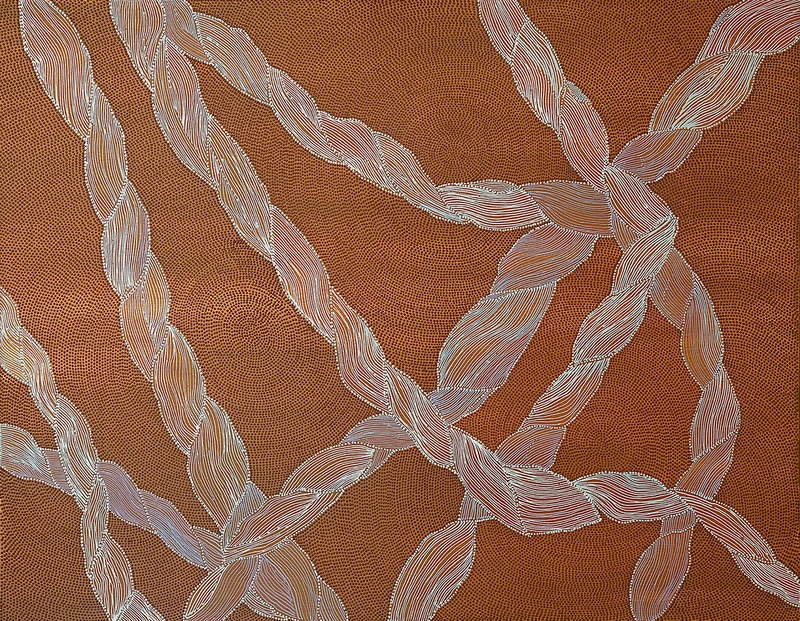RE: Imagined
29 Oct-6 Dec 2025
PV 29 Oct 2025, 6.30-8.30pm


Konstantina’s practice spans archival research, writing, social practice and small-scale sculpture, installation, film, and painting. Her engagement with each of these disciplines, however, began with a more singular directive in mind: the reassertion and recognition of her Gadigal heritage in opposition to its historic erasure. Konstantina reclaims and shares her story and family history, presenting connections to her Aboriginality which have been whitewashed since her great-grandmother’s generation. Her work documents a personal journey of rediscovery, exploring her identity and reintegrating Gadigal culture and language back into her own family’s customs.
During her ongoing research project with the British Museum (2023 − present) Konstantina examines First Nations Australian objects which are currently part of the Museum’s collection. These objects number over 6,000 items and many have never been displayed since they were taken from Indigenous communities in various collecting contexts, often without consent and sometimes in circumstances of extreme violence, during the project of colonisation in Australia. Konstantina’s research explores the materials from which these objects were made, as well as the techniques used to make them. From her home and studio on Bundjalung Country (Byron Bay), Konstantina enters the second phase of her project, remaking these objects using traditional materials, such as river reeds, possum skin, bark and shells, and Gadigal skill sets, including bag weaving, making and adorning possum skin cloaks, and necklace design. After this phase, Konstantina reimagines these objects through non-traditional mediums and making processes, including beading and embroidery, creating a new ‘roadmap’ for contemporary manifestations of Gadigal material culture.
'RE: Imagined' showcases the results of the most recent phase of Konstantina’s project: paintings inspired by the raw materials which Gadigal used to fashion the objects housed in the British Museum, and the original environments from which these materials were sourced. Her paintings are titled with the Gadigal word for either the material, or the item of clothing or accessory which it is used to make. Narang Barraba, for example, is the Gadigal word for a small reed or bulrush from which Gadigal make necklaces, waistlets and chaplets. Konstantina interprets the young plant as if through its distorted reflection in the water it is commonly found growing beside, or as a dark silhouette set against glaring sunlight. In the upper right of the painting, radials of white dots emanate from a central point, which suggest a ripple or the sun’s halo. These radials are broken by less dense lines of gold dots creating darker recesses, which resemble the elongated forms of reeds. Through this treatment, Konstantina depicts the material in its early stages of growth, within its natural environment, before the mature plant is harvested and dried.
Konstantina frames the reed and ripple or sun motifs with an irregular white border which sections them from an earthen backdrop, as if they are specimens of study suspended in a lantern slide. This composition references the practice of collecting and examining botanical specimens from ‘exotic’ outposts like Australia, during the “great colonial voyages” of Nicolas Baudin and Matthew Flinders, and the interpretation of these specimens through drawing and watercolour, as in the work of Joseph Banks, James Cook and Sydney Parkinson. By alluding to her subject’s life within this manner of composition, Konstantina’s work suggests that materials and so-called ‘artefacts’ from First Nations communities, which are held by museums and institutions, are not inert, but objects with living histories, and are contemporary social, spiritual and useful tools in the communities that they are from.
Konstantina’s wider work is marked by observations and analysis of this nature; almost everything she encounters in her investigation of culture, colonialism, language and lore, she documents through a visual medium, accompanied by text in the form of fragments, reflections or aphorisms. Often, she will work with a particular theme in mind. Her series, 'Raining on Eora' (2021−22), for example, took locations in the Sydney area as starting points from which to tell stories about their significance in First Nations culture through painting and writing. 'RE: Imagined' follows this course of revivifying Gadigal cultural memory and begins to imagine a future for traditional practices.
RE: Imagined press release
Download